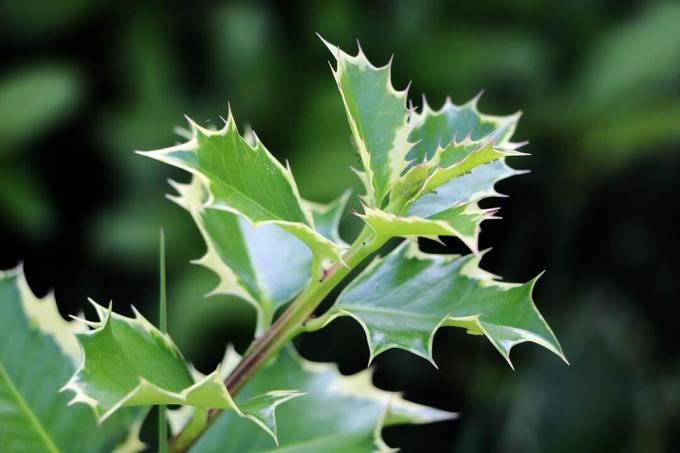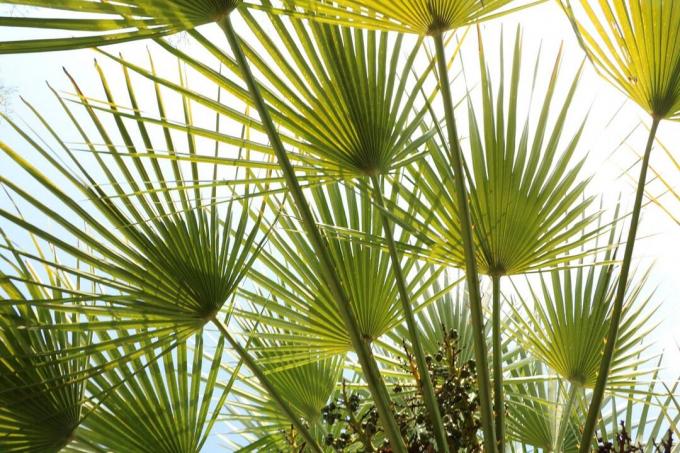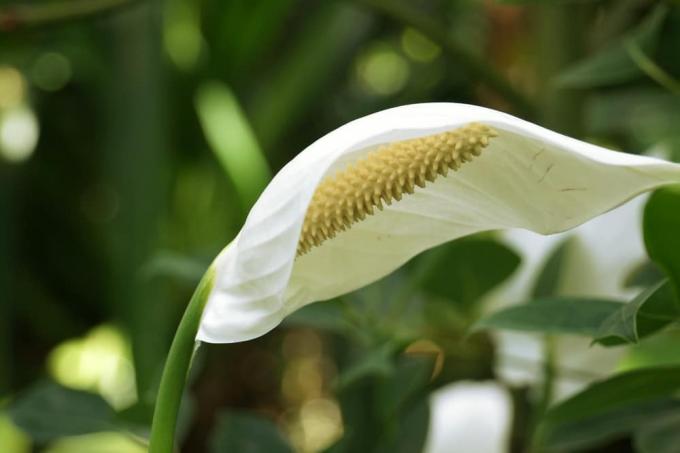
Table of contents
- Advice on exotic garden plants
- Popular Varieties
- Demands and special features of the unusual species
- Suitable exotics for the room
- Conclusion
Garden and indoor plants with exotic origins or unusual looks are popular living decorations. Especially in the garden, however, they are often exposed to unfamiliar and unfavorable influences and therefore require special protection. Therefore, when making the selection, it is important to consider whether the plants are suitable for the local climate and how they need to be overwintered. This point is not only crucial for plants in the garden, overwintering can also mean a not inconsiderable amount of extra work for indoor plants.
Advice on exotic garden plants
Exotic garden plants - whether from Asia, America or the Mediterranean - need one thing above all: protection. The location should therefore be chosen with care. As a rule, it must be warm and protected from wind and rain. These properties come into play especially in winter, when frost and winter sun make things difficult for the plants. In addition to the location, the substrate is crucial. The soil urgently needs to be attuned to the exotic garden plant so that it can thrive. Planting freely in the garden is sometimes difficult, since even with a large excavation, sooner or later there will be washing and mixing. This is particularly problematic with regard to the pH value - but it can be avoided by cultivating in a bucket or by making a careful selection. Last but not least, winter needs attention. If you choose an exotic garden plant, you should note that it should either be overwintered indoors or protected outdoors. There are only a few exceptions to this rule and only when it comes to mild winters. In most cases, the decision for exotics means more effort and should be carefully considered for this reason alone and the possibly increased space requirement.
Popular Varieties
While cultivating exotics in the garden can be difficult, with the right selection it is by no means impossible. For example:

agave
Dry and sandy soil that allows for rapid water drainage and a sunny location with protection from wind and cold - the agave is already happy. Nevertheless, the appearance of the thick-fleshed plant is anything but boring or ordinary. Only in longer and harsher winters does the unusual plant need some protection. Alternatively, it can be grown in a bucket, at least initially.
bamboo
Bamboo simply cannot be missing in the exotic, Asian garden. The thin to impressively thick stems grow incredibly fast, can serve as privacy screens and become the backdrop for decorations. In addition, the bamboo requires very little care, but the right location.
prickly pear
The roots of the prickly pear cactus want it to be dry and permeable, then the unusual plant usually thrives without any problems and without much effort. Initially, however, overwintering indoors is advisable, because the young plants are hardly hardy and are quickly damaged in the cold season.
kiwi
The climbing kiwi can stand alone or be planted in groups to bear fruit. In any case, it needs a climbing aid to thrive and unfold its full beauty. In any case, it is exotic in the home garden.
magnolia
Hardy magnolia species are now increasingly available in stores. And that to the delight of hobby gardeners. The lush flowering plants are real eye-catchers in the garden and do not even expect complex or unusual care.
yucca
Better known as a houseplant, new cultivated forms of the yucca palm are now hardy in this country too. They are therefore ideally suited for the palm garden or the exotic corner in your own green. Nevertheless, young yuccas should still be overwintered indoors and should first be cultivated in a bucket.
Demands and special features of the unusual species
Due to the mostly fairly constant temperatures and the easier to control conditions, it is much easier to cultivate exotics as houseplants. Exotic plants such as orchids or cacti are therefore very popular. Not least because they are easy to maintain. Nevertheless, they also have special requirements that need to be considered. This includes taking humidity into account. Desert plants, such as succulents, also thrive in dry, heated air. The same applies to significant temperature fluctuations between day and night in rooms that are only occasionally heated. Tropical plants, such as numerous types of orchids, on the other hand, require high humidity and constant temperatures. The bathroom and kitchen or a greenhouse are therefore better locations for them. Apart from that, many exotic plants can be cultivated in the same way, so they do not need a separate location for wintering and also no changed care. Here, too, there are differences that should be considered when making a purchase decision.
Suitable exotics for the room
Suitable and in some cases already popular exotic houseplants are:
aloe
Moist in summer, dry in winter but always in loose soil - the aloe or, to be more precise, real aloe vera has only low requirements and is the ideal houseplant. It is not only decorative - its thick fleshy and only slightly toothed leaves can in the case of Insect bites, burns or other injuries can also be easily cut off and used to treat the wounds be used. In summer, the succulents can also be placed outdoors. However, they do not need a separate hibernation.
avocado
The avocado is well known as an ingredient in salads and on sandwiches, but it is still underestimated as a houseplant. The plant is very easy to care for and does not need a separate hibernation, instead it can spend the whole year in normal room temperatures.
elephant foot
Testudinarie or elephant's foot, this plant is already optically an unparalleled exotic. Originally from South Africa, the rhythm is a bit off. Quiet in summer, growth in winter – the world is upside down. The plant is watered plentifully and well fertilized in the cool season, but in summer it may only be an occasional sip of water. The interestingly growing elephant's foot with the thick and furrowed tuber survives the holiday without any problems.
candlestick flower
The candlestick flower is an extremely undemanding houseplant that is best cultivated in hanging baskets or with an appropriate climbing aid. Damp or dry, 10 or 24°C – the candlestick flower is anything but choosy and adapts quickly.
mango
Grow it yourself or buy it - the mango is an unusual and, above all, rare ornament that is still hardly known as a plant. If it gets enough sun, it is also surprisingly easy to care for as a houseplant and is ideal even for beginners.
orchid
The care required for orchids depends solely on the species. The well-known and popular Phalaenopsis, for example, does not require much work, but flowers breathtakingly beautifully when cultivated correctly and is even quite easy to propagate. With the Dendrobium it looks different. Here you should research in advance what is required for successful cultivation.
porcelain flower
The porcelain or wax flower is a real ornament and not just visually. The flowers are beautiful to look at as a hemisphere and also spoil the nose. The luxuriantly growing exotic does not require much effort, quite the opposite.
room aralie
Little light, little care, fluctuating temperatures and overall poor conditions at the location? None of this is a problem for the Zimmeraralie. Nevertheless, it grows to a stately size in a short time and requires little effort. Especially beginners and hobby gardeners with little time will enjoy it.
indoor hops
Decorative and colored spikes all year round – indoor hops offer this for a minimum of effort and care. In addition, the ornamental hops do not run the risk of becoming too large for the chosen location by cutting them quickly into the desired shape. This exotic houseplant is therefore not only an insider tip for beer lovers.
Conclusion
If you want to call exotic indoor and garden plants your own, you don’t always have to invest a lot of effort. There are quite a number of plants that impress with their unusual appearance - without requiring a lot of time and work. Only the selection can be a challenge.
 garden editorial
garden editorial I write about everything that interests me in my garden.
Learn more about Exotic Plants

Holly, holly: care from A to Z
The European holly is one of the evergreen plants. It reaches a height of up to five meters and is ideal as a Christmas decoration or garden shrub. The native, although rarely occurring plant is the only native representative of the Ilex family and is particularly easy to care for and robust.

Dwarf palm, Chamaerops humilis: care instructions
The dwarf palm remains small enough that it can also be cared for in the room. However, it also cuts a fine figure in the garden. You can find out here how it is maintained and what needs to be considered.

Dwarf date palm, Phoenix roebelenii: Care from A-Z
The dwarf date palm (Phoenix roebelenii) is a particularly small, actually the smallest palm species of its genus. But that doesn't make them any less decorative. It is the most filigree and elegant date palm and hardly grows higher than one meter.

Growing vanilla plants: 11 tips for care
The vanilla plant is truly exotic in Central Europe and cannot be found in every garden. Vanilla planifolia forms the aromatic pods for which the plant is known. The cultivation of a vanilla plant is easily possible with the right care tips.

Kangaroo Paw: Caring for the kangaroo plant
Kangaroo paws are exotic plants native to southwestern Australia. Considering the care instructions, Kangaroo Paw can also thrive in Central European conditions. Maintenance requires a little more effort. If the plant gets enough attention, it will thank you with magnificent inflorescences.

Einblatt, Spathiphyllum: care from A to Z
Because of simple! The single sheet draws everyone's attention with its extravagant appearance. The imposing flower gives sophisticated rooms that certain something. If the houseplant is in the right place, hardly any care is required. The breeder can find out here what demands Spathiphyllum places on their location.
